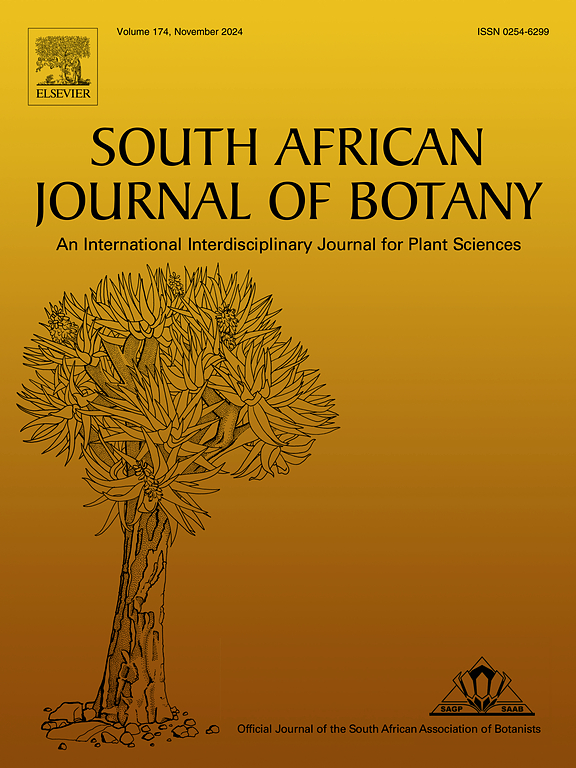配方海藻提取物与黄菖蒲提取物对黄菖蒲生长、产量、品质和经济性的促进作用比较评价。例直流
IF 2.7
3区 生物学
Q2 PLANT SCIENCES
引用次数: 0
摘要
以海藻为基础的生物刺激剂已经成为提高作物性能的有前途的、环保的投入物。然而,它们对药用和芳香植物(如淡色蒿)的比较功效仍未得到充分研究。因此,我们于2023-2024年在印度班加罗尔csir -中央药用和芳香植物研究所开展了野外试验,以评估半干旱热带条件下Gracilaria edulis海藻提取物(GLE)对黄蒿(Artemisia pallens)生长、产量和精油品质的影响。田间试验采用随机完全区组设计,共有8个处理,包括5个浓度为2.5%至15%的GLE和推荐剂量的肥料(RDF),一种浓度为0.25% (SKG)的商业海藻配方(Sagarika)和RDF和Sole RDF作为对照处理。GLE从移栽后30天开始,每隔30天喷施一次叶面喷雾。与对照相比,施用10% GLE显著提高了淡色菊的生长和产量性状,其效果与0.25% SKG相当。值得注意的是,10%的GLE比对照组(13.32公斤(⁻)和27.27公斤(⁻))产生了更高的牧草产量(17.78吨)和精油产量(39.00公斤(⁻)),在统计上与0.25%的SKG处理相似。10% GLE施用的土壤养分效率和经济效益最高,效益成本比(B:C比)为3.38。精油回收率不受GLE应用的影响,范围从0.19%到0.23%。此外,GLE应用表现出顺式达瓦酮、达瓦酮醚(异构体-1)和双环丙烯浓度的边际增加。而海藻提取物对精油成分的影响无统计学意义。综上所述,在不显著改变黄樟精油成分的情况下,添加10% GLE可有效促进黄樟的生长、产量和盈利能力。本文章由计算机程序翻译,如有差异,请以英文原文为准。
Comparative evaluation of formulated and Gracilaria edulis derived seaweed extract in enhancing growth, yield, quality and economics of Artemisia pallens Wall. ex. DC
Seaweed-based bio stimulants have emerged as promising, eco-friendly inputs for enhancing crop performance. However, their comparative efficacy on medicinal and aromatic plants like Artemisia pallens remains underexplored. Therefore, a field experiment was conducted at CSIR-Central Institute of Medicinal and Aromatic Plants, Bengaluru, India, during 2023–2024 to evaluate the effect of Gracilaria edulis seaweed extract (GLE) on the growth, yield, and essential oil quality of Artemisia pallens under semi-arid tropical conditions. The field experiment was laid out in a randomized complete block design with eight treatments, including five concentrations of GLE ranging from 2.5 % to 15 % along with the recommended dose of fertilizers (RDF), a commercial seaweed formulation (Sagarika) at 0.25 % (SKG) with RDF and Sole RDF as a control treatment. GLE was applied as a foliar spray at 30-day intervals from 30 days after transplanting. Application of 10 % GLE significantly enhanced the growth and yield traits of A. pallens compared to the control, with effects comparable to those of 0.25 % SKG. Notably, 10 % GLE resulted in higher herbage yield (17.78 t ha⁻¹) and essential oil yield (39.00 kg ha⁻¹) than the control (13.32 t ha⁻¹ and 27.27 kg ha⁻¹), and was statistically similar to the 0.25 % SKG treatment. Highest agronomic nutrient efficiency and economic return, with a benefit-cost ratio (B:C ratio) of 3.38 was also recorded in 10 % GLE application. The essential oil recovery remained unaffected by GLE application, ranging from 0.19 % to 0.23 %. Furthermore, the GLE application exhibited marginal increases in the concentrations of cis-Davanone, davana ether (Isomer-1), and bicyclogermacrene. However, the influence of seaweed extract on the essential oil composition was not statistically significant. In conclusion, the application of 10 % GLE offers a sustainable and effective strategy to enhance the growth, yield, and profitability of A. pallens without significantly altering essential oil composition.
求助全文
通过发布文献求助,成功后即可免费获取论文全文。
去求助
来源期刊

South African Journal of Botany
生物-植物科学
CiteScore
5.20
自引率
9.70%
发文量
709
审稿时长
61 days
期刊介绍:
The South African Journal of Botany publishes original papers that deal with the classification, biodiversity, morphology, physiology, molecular biology, ecology, biotechnology, ethnobotany and other botanically related aspects of species that are of importance to southern Africa. Manuscripts dealing with significant new findings on other species of the world and general botanical principles will also be considered and are encouraged.
 求助内容:
求助内容: 应助结果提醒方式:
应助结果提醒方式:


